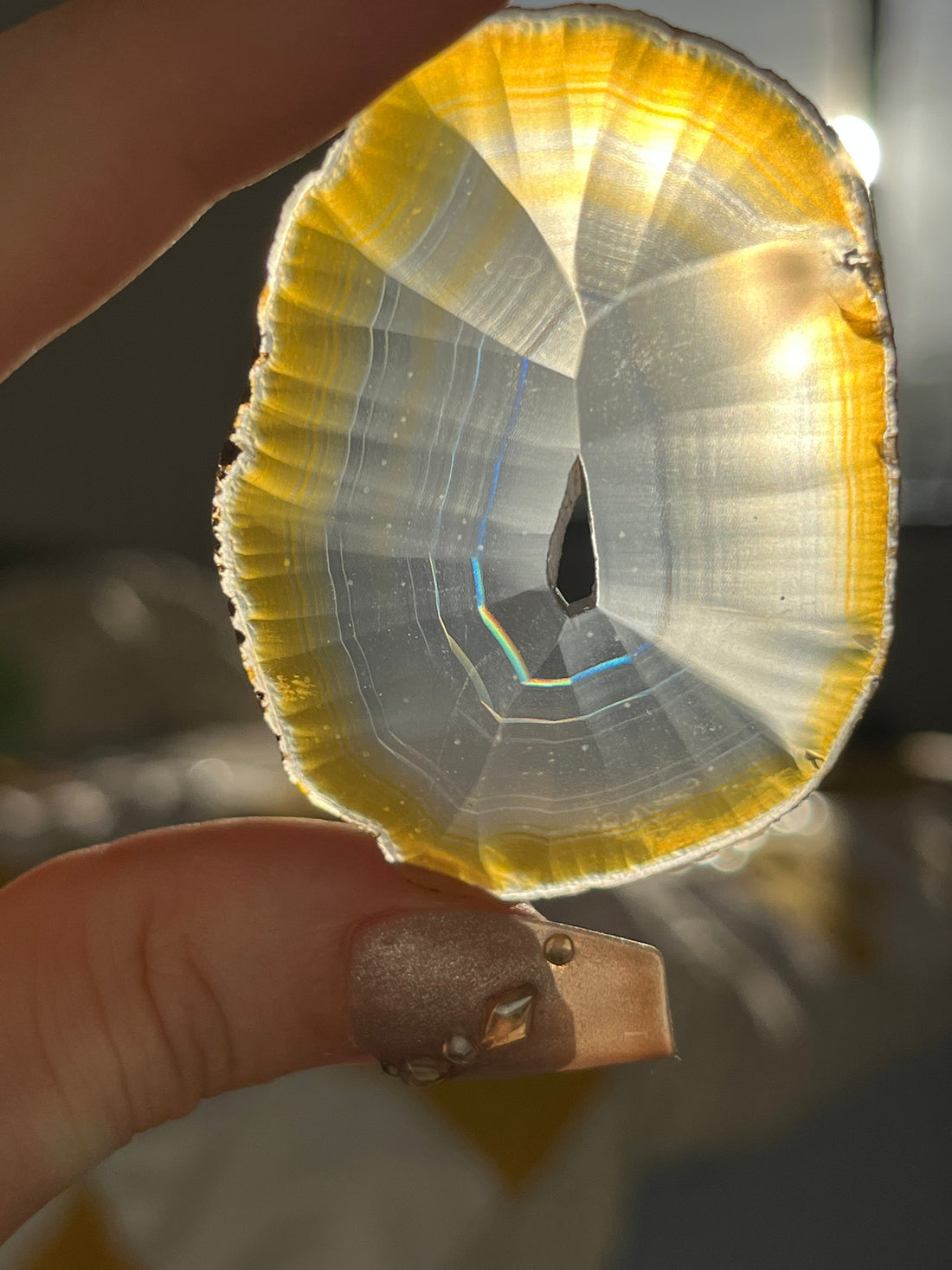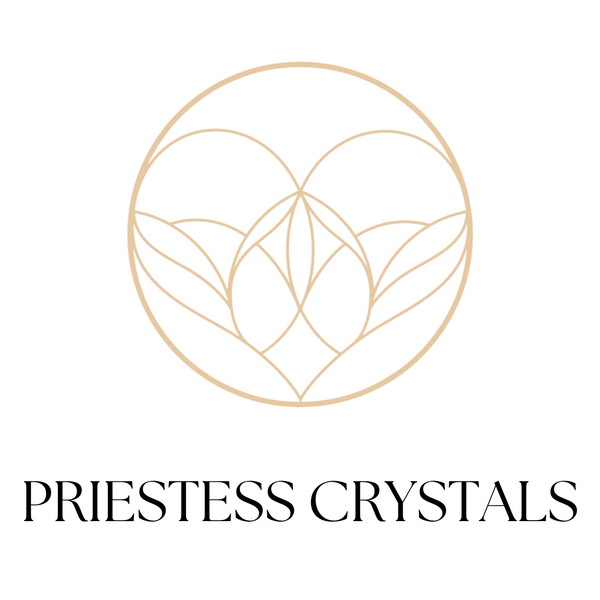
Iris Agate: A Guide to the Rainbow Gemstone
Share
Let’s get one thing straight...
There’s a lot of buzz surrounding Iris Agate, and for good reason.
For those of us obsessed with finding stones that give us that magical, almost otherworldly aesthetic, Iris Agate scratches the perfect itch - the crystal collecting itch, that is. While agates are a relatively common mineral, this rainbow effect observed in Iris Agates is not only uncommon, but very desirable.
Its name is owed to the iridescent display of colours that seem to shift and shimmer in the light. While Iris Agate might not have the same notoriety as some other crystals, it’s gaining attention, and for good reason.
This is the start of our deep dive into Iris Agate—a gemstone that’s more than meets the eye.
What is Iris Agate?
Iris Agate isn’t your average agate. It’s a unique variety of agate that displays iridescence, meaning it displays a mesmerising, rainbow-like glow when light hits it just right.
Unlike regular agates, which often feature opaque or semi-translucent bands of chalcedony in various colours, Iris Agate’s beauty lies in its ability to shift between hues as the angle of light and hence refraction, changes. It's a crystal that offers a constantly changing visual experience, almost like nature’s own light show of the aurora borealis.
The colours typically range from vibrant purples and blues to soft oranges and yellows. These shifting colours make it a favorite for those who love an aesthetic and interactive crystal to engage with.
Where Does Iris Agate Come From?
Iris Agate isn’t something you’ll find just anywhere. It’s relatively rare and is primarily found in specific parts of the world. The majority of us having first interacted with the Iris Agate that comes out of Indonesia.
However, this is not the only country where one can find this rainbow producing gem. Iris Agate has been documented in countries such as Australia and Mexico as well as the United States. Iris Agate is not exclusive to one country and can form provided the conditions are right to produce its iconic spectrum of colours).
It's certainly not one of those crystals you’ll easily find in abundance, which is part of what makes it so alluring to collectors.
How is Iris Agate Formed?
Iris Agate, like all agates, forms in volcanic rocks, typically in cavities left by gas bubbles. Over millions of years, silica rich water seeps into these cavities, and over time, layers of agate form.
What makes Iris Agate stand out is the way these layers form.
The way in which the microstructure of silicon dioxide forms plays a key role in producing the vivid, rainbow-like effect. microscopic crystals within the stone reflect light, which gives the gemstone its iridescent glow.
Is Iris Agate Real? Is Iris Agate Natural?
You might be wondering—Is Iris Agate a real or fake crystal?
Iris Agate is a genuine, naturally occurring crystal. It’s not man-made or artificially coloured. The iridescence is something that’s developed naturally within the stone. That said, like many gemstones, it can be treated to enhance its colours. But even in its untreated form, Iris Agate is a true natural beauty.
Is Iris Agate Rare?
Yes, Iris Agate is considered rare.
Not only is the formation of Iris Agate a rare occurrence, but the specific conditions needed to create its stunning iridescence aren’t found everywhere. So, if you come across a piece, it’s definitely worth appreciating its rarity. Iris Agate isn’t something you’ll find in every crystal shop, and high-quality, untreated specimens are particularly sought after by collectors.
What Causes the Rainbow Effect in Iris Agate?
The rainbow-like effect in Iris Agate can only be appreciated when held up against light like the sun or an artificial light source such as from halogen bulbs or LEDs. This spectrum of colours that we observe comes from the internal structure of the stone.
Tiny, microscopic quartz crystals within the agate’s layers refract (bend) light as the light source passes from outside the agate to within the cryptocrystalline quartz layers; bending it in such a way that it creates that beautiful spectrum of colours.
When the light hits the stone from different angles, you can see the stone's iridescence change and shift, giving it that almost magical, chameleon-like quality.
It's certainly nature’s way of showing off.
(Image 1: An untreated specimen of Laguna Iris Agate from Chihuahua, Mexico against a plain background (left) and in sunlight (right). Photo credit: Priestess Crystals)
Is Iris Agate a Natural Crystal or Is It Treated?
Iris Agate, in its purest form, is a natural crystal.
However, like many gemstones, it can be treated to enhance its visual appeal.
Some treatments might include heat chemical treatment to enhance the colours and overall appearance of the Iris Agate rainbow effect.
After speaking with our contacts in Indonesia, we were surprised to learn about a chemical treatment we had never encountered before: yeast fermentation reaction. Suppliers will often use this treatment to enhance the overall rainbow appearance of Iris Agate. Approximately 50% or 1 in every 2 Iris Agates from Indonesia have been treated in this manner. The tricky thing is - there's no way to tell of its treatment 100% of the time unless the person who processed the Iris Agate has informed you. At Priestess Crystals, we suspect that specimens which appear to have an almost completely clear chalcedony, showing only the rainbow, have been treated (an example image is shown below).
(Image 2: Iris Agate slice carved into a heart shape from an overseas wholesaler. We suspect that these carvings which display a very clear to white chalcedony have been chemically treated to enhance the observed rainbow effect in Iris Agate specimens. This information would need to be verified with each seller as to the treatment and processing of the Iris Agate)
In saying so - you cannot synthetically alter an agate to be able to produce the rainbow of colours that we see in Iris Agate; the stone has to already possess the natural internal crystal structure to allow for light to bend and produce the beautiful spectrum of colours that we know and love.
These processes don’t alter the fact that Iris Agate is a naturally occurring stone. The core of the stone—the iridescent layers that create the rainbow effect—is all natural and treatment will only enhance what is already there.
(For natural, untreated Iris Agate specimens, you can view our collection online here).
What is the Process of Treatment for Iris Agate?
If you're buying Iris Agate, knowing whether it's been treated or not, can make a difference to collectors. Untreated stones can sometimes be more valuable due to their untouched nature. Personal preference also plays a significant part in the purchasing decision of the individual collector. At the end of the day - the choice is yours!
Wrapping It Up
So, there you have it— a mini guide on Iris Agate, from its formation to its incredible, rainbow-like glow. Whether you’re a seasoned collector or just getting started with Iris Agate, I hope this little guide helps you better understand this fascinating and beautiful agate. It's one of those stones that’s not only visually appealing; it is interactive and can provide you with hours of entertainment gazing at its play of rainbow colours.
Natural Iris Agates are a true mineral marvel and something to be treasured.
As with any gemstone, it’s always helpful to ask questions and do a little digging (pun intended!) before making a purchase. If knowing how your Iris Agate has been treated is important to you, always purchased from trusted source that can provide you with that information.
Until next time, happy crystal hunting!
Alisha xx
What do you think of Iris Agate? Have you seen its magical rainbow effect in person? Or a total newbie? Drop your thoughts in the comments—let’s keep the conversation going!
If you’re looking to add some Iris Agate to your collection, check out our range of high-quality pieces here and see for yourself the mesmerising spectrum of aura colours this crystal has to offer x

